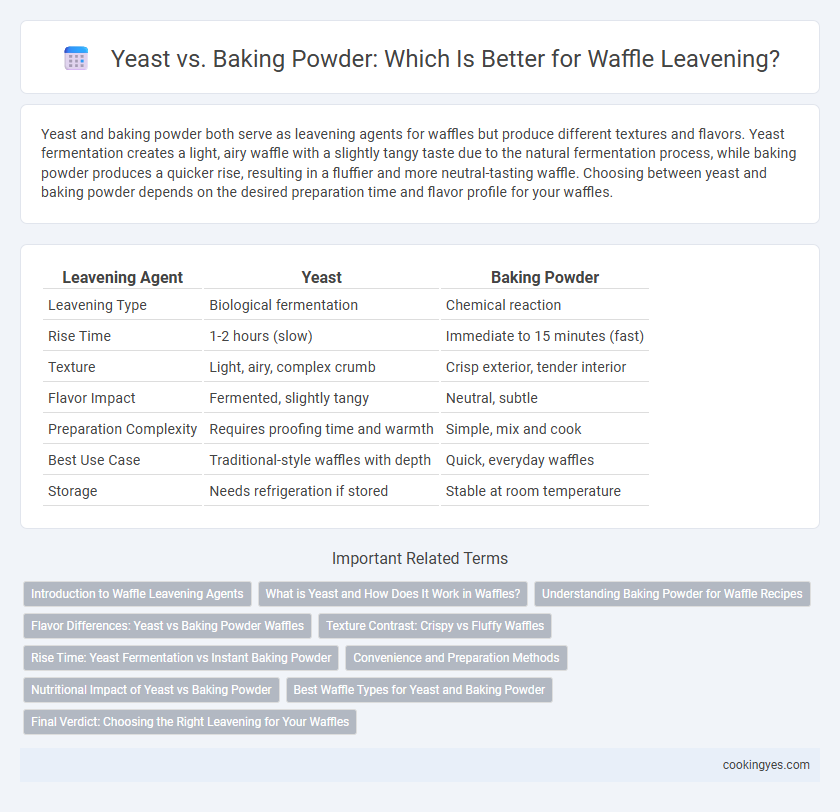Yeast and baking powder both serve as leavening agents for waffles but produce different textures and flavors. Yeast fermentation creates a light, airy waffle with a slightly tangy taste due to the natural fermentation process, while baking powder produces a quicker rise, resulting in a fluffier and more neutral-tasting waffle. Choosing between yeast and baking powder depends on the desired preparation time and flavor profile for your waffles.
Table of Comparison
| Leavening Agent | Yeast | Baking Powder |
|---|---|---|
| Leavening Type | Biological fermentation | Chemical reaction |
| Rise Time | 1-2 hours (slow) | Immediate to 15 minutes (fast) |
| Texture | Light, airy, complex crumb | Crisp exterior, tender interior |
| Flavor Impact | Fermented, slightly tangy | Neutral, subtle |
| Preparation Complexity | Requires proofing time and warmth | Simple, mix and cook |
| Best Use Case | Traditional-style waffles with depth | Quick, everyday waffles |
| Storage | Needs refrigeration if stored | Stable at room temperature |
Introduction to Waffle Leavening Agents
Yeast and baking powder serve as primary leavening agents in waffle recipes, each influencing texture and flavor differently. Yeast fermentation produces carbon dioxide slowly, resulting in waffles with a light, airy crumb and distinct tangy taste. Baking powder generates gas rapidly through chemical reaction, yielding waffles with immediate rise and a tender, uniform structure.
What is Yeast and How Does It Work in Waffles?
Yeast is a living microorganism that ferments sugars in waffle batter, producing carbon dioxide gas that causes the batter to rise and develop a light, airy texture. This fermentation process also enhances flavor complexity by generating subtle tangy and yeasty notes unique to yeast-leavened waffles. Yeast requires time to activate and ferment, resulting in waffles with a chewy crumb and distinctive aroma compared to the quick rise and slight crispness from baking powder.
Understanding Baking Powder for Waffle Recipes
Baking powder is a chemical leavening agent composed of an acid and a base that produces carbon dioxide gas when moistened and heated, causing waffle batter to rise and become light and fluffy. Unlike yeast, baking powder works quickly without requiring fermentation time, making it ideal for fast waffle preparation. Its consistent and reliable reaction ensures uniform texture and tender crumb in waffles, making it a preferred choice for many recipes.
Flavor Differences: Yeast vs Baking Powder Waffles
Yeast waffles develop a rich, complex flavor with subtle tangy and fermented notes, contributing to a more artisanal taste and a slightly chewy texture. Baking powder waffles offer a lighter, milder flavor with a tender, crisp exterior and a soft, fluffy interior, ideal for those preferring a straightforward, sweet profile. The choice between yeast and baking powder significantly influences the waffle's aroma and taste, with yeast enhancing depth and baking powder emphasizing simplicity.
Texture Contrast: Crispy vs Fluffy Waffles
Yeast-leavened waffles develop a complex, crispy exterior with an airy, chewy crumb due to fermentation that creates bubbles and enhances flavor. Baking powder waffles result in a lighter, fluffier texture with a softer bite, as chemical leavening rapidly produces carbon dioxide for immediate rise. Yeast waffles typically exhibit a more pronounced texture contrast between a crunchy crust and soft interior, while baking powder waffles prioritize uniform fluffiness throughout.
Rise Time: Yeast Fermentation vs Instant Baking Powder
Yeast fermentation requires a longer rise time, often ranging from 1 to 2 hours, allowing the dough to develop complex flavors and a light, airy texture in waffles. Instant baking powder reacts immediately when mixed with wet ingredients, producing carbon dioxide rapidly and enabling batter to rise quickly, typically within minutes. The choice between yeast and baking powder significantly impacts preparation time and flavor depth in waffle making.
Convenience and Preparation Methods
Yeast waffles require longer preparation time due to fermentation, offering a richer flavor but less convenience for quick meals. Baking powder waffles provide a faster leavening process, ideal for immediate batter use and consistent results. Choosing baking powder simplifies preparation, making it suitable for busy schedules and effortless cooking.
Nutritional Impact of Yeast vs Baking Powder
Yeast-fermented waffles often contain lower sodium levels compared to those made with baking powder, which typically includes sodium bicarbonate contributing to higher salt content. Yeast fermentation can enhance nutrient absorption by breaking down phytates and increasing B-vitamin content, whereas baking powder does not affect nutritional composition beyond leavening. Additionally, yeast-based waffles may have a lower glycemic index due to slower carbohydrate digestion, benefiting blood sugar regulation compared to quick-rise baking powder waffles.
Best Waffle Types for Yeast and Baking Powder
Yeast-leavened waffles, such as Belgian Liege waffles, offer a rich, airy texture with a slightly tangy flavor due to fermentation, making them ideal for traditional, thick, and crispy waffles. Baking powder works best in classic American-style waffles, providing a quick rise that results in light, fluffy waffles with a tender crumb. Choosing yeast enhances complexity and chewiness, while baking powder ensures convenience and a softer, uniform texture.
Final Verdict: Choosing the Right Leavening for Your Waffles
Yeast-leavened waffles offer a richer, fermented flavor and a chewier texture, ideal for those seeking a traditional taste, while baking powder provides a quicker, lighter rise resulting in crispier, fluffier waffles perfect for convenience and consistency. For authentic Belgian-style waffles, yeast is the preferred leavening agent, whereas baking powder suits everyday waffles with minimal preparation time. Selecting the right leavening depends on desired texture, flavor complexity, and preparation time, ensuring optimal waffle quality every time.
Yeast vs Baking Powder for waffle leavening Infographic

 cookingyes.com
cookingyes.com